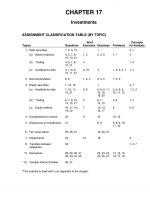Lecture Intermediate Accounting (13th edition) - Chapter 17: Investments
Bạn đang xem bản rút gọn của tài liệu. Xem và tải ngay bản đầy đủ của tài liệu tại đây (2.13 MB, 117 trang )
Chapter
17-1
CHAPTER
17
INVESTMENTS
Intermediate Accounting
13th Edition
Kieso, Weygandt, and Warfield
Chapter
17-2
Learning Objectives
Learning Objectives
1.
Identify the three categories of debt securities and describe the accounting and reporting treatment for
each category.
2.
Understand the procedures for discount and premium amortization on bond investments.
3.
Identify the categories of equity securities and describe the accounting and reporting treatment for
each category.
4.
Explain the equity method of accounting and compare it to the fair value method for equity securities.
5.
Describe the accounting for the fair value option.
6.
Discuss the accounting for impairments of debt and equity investments.
7.
Explain why companies report reclassification adjustments.
8.
Describe the accounting for transfer of investment securities between categories.
Chapter
17-3
Investments
Investments
Investments in
Debt Securities
Investments in
Equity Securities
Other Reporting
Issues
Held-to-maturity
securities
Holdings of less than
20%
Impairment of value
Available-for-sale
securities
Holdings between 20%
and 50%
Trading securities
Holdings of more than
50%
Fair value option
Reclassification
adjustments
Transfers between
categories
Fair value
controversy
Summary
Chapter
17-4
Investment Accounting Approaches
Investment Accounting Approaches
Different motivations for investing:
To earn a high rate of return.
To secure certain operating or financing arrangements with
another company.
Chapter
17-5
Investment Accounting Approaches
Investment Accounting Approaches
Companies account for investments based on
the type of security (debt or equity) and
their intent with respect to the investment.
Illustration 171
Chapter
17-6
Investments in Debt Securities
Investments in Debt Securities
Debt securities (creditor relationship):
Type
Accounting Category
U.S. government
securities
Heldtomaturity
Municipal securities
Trading
Corporate bonds
Availableforsale
Convertible debt
Commercial paper
Chapter
17-7
LO 1 Identify the three categories of debt securities and describe the accounting and
reporting treatment for each category.
Investments in Debt Securities
Investments in Debt Securities
Accounting for Debt Securities by Category
Illustration 172
Chapter
17-8
LO 1 Identify the three categories of debt securities and describe the accounting and
reporting treatment for each category.
HeldtoMaturity Securities
HeldtoMaturity Securities
Classify a debt security as heldtomaturity only if it has both
(1)
the positive intent and
(2)
the ability to hold securities to maturity.
Accounted for at amortized cost, not fair value.
Amortize premium or discount using the effectiveinterest method
unless the straightline method yields a similar result.
Chapter
17-9
LO 2 Understand the procedures for discount and premium
amortization on bond investments.
HeldtoMaturity Securities
HeldtoMaturity Securities
Illustration: KC Company purchased $100,000 of 8 percent bonds of
Evermaster Corporation on January 1, 2009, at a discount, paying $92,278.
The bonds mature January 1, 2014 and yield 10%; interest is payable each July
1 and January 1. KC records the investment as follows:
January 1, 2009
HeldtoMaturity Securities
Cash
Chapter
17-10
92,278
92,278
LO 2 Understand the procedures for discount and premium
amortization on bond investments.
HeldtoMaturity Securities
HeldtoMaturity Securities
Illustration 173
Schedule of Interest
Revenue and Bond
Discount Amortization
—
EffectiveInterest
Method
Chapter
17-11
LO 2
HeldtoMaturity Securities
HeldtoMaturity Securities
Illustration: KC Company records the receipt of the first semiannual interest
payment on July 1, 2009, as follows:
July 1, 2009
Cash
4,000
HeldtoMaturity Securities
614
Interest Revenue
4,614
Chapter
17-12
LO 2 Understand the procedures for discount and premium
amortization on bond investments.
HeldtoMaturity Securities
HeldtoMaturity Securities
Illustration: KC is on a calendaryear basis, it accrues interest and amortizes
the discount at December 31, 2009, as follows:
December 31, 2009
Interest Receivable
4,000
HeldtoMaturity Securities
645
Interest Revenue
4,645
Chapter
17-13
LO 2 Understand the procedures for discount and premium
amortization on bond investments.
HeldtoMaturity Securities
HeldtoMaturity Securities
Reporting of HeldtoMaturity Securities
Illustration 174
Chapter
17-14
LO 2 Understand the procedures for discount and premium
amortization on bond investments.
HeldtoMaturity Securities
HeldtoMaturity Securities
Illustration: Assume that KC Company sells its investment in Evermaster
bonds on November 1, 2013, at 99.75 plus accrued interest. KC records this
discount amortization as follows:
November 1, 2013
HeldtoMaturity Securities
635
Interest Revenue
635
$952 x 4/6 = $635
Chapter
17-15
LO 2 Understand the procedures for discount and premium
amortization on bond investments.
HeldtoMaturity Securities
HeldtoMaturity Securities
Computation of the realized gain on sale.
Illustration 175
Cash
Interest Revenue (4/6 x $4,000)
HeldtoMaturity Securities
Chapter
17-16
Gain on Sale of Securities
102,417
2,667
99,683
67
LO 2
AvailableforSale Securities
AvailableforSale Securities
Debt
Securities
Companies report availableforsale securities at
fair value, with
unrealized holding gains and losses reported as part of
comprehensive income (equity).
Any discount or premium is amortized.
Chapter
17-17
LO 2 Understand the procedures for discount and premium
amortization on bond investments.
Debt
Securities
AvailableforSale Securities
AvailableforSale Securities
Illustration (Single Security): Graff Corporation purchases $100,000, 10
percent, fiveyear bonds on January 1, 2009, with interest payable on July 1 and
January 1. The bonds sell for $108,111, which results in a bond premium of
$8,111 and an effective interest rate of 8 percent. Graff records the purchase of
the bonds on January 1, 2009, as follows.
AvailableforSale Securities
Cash
Chapter
17-18
108,111
108,111
LO 2 Understand the procedures for discount and premium
amortization on bond investments.
AvailableforSale Securities
AvailableforSale Securities
Debt
Securities
Illustration 176
Schedule of Interest
Revenue and Bond
Premium Amortization
—
EffectiveInterest
Method
Chapter
17-19
LO 2
Debt
Securities
AvailableforSale Securities
AvailableforSale Securities
Illustration (Single Security): The entry to record interest revenue on July 1,
2009, is as follows.
Cash
5,000
AvailableforSale Securities
Interest Revenue
Chapter
17-20
676
4,324
LO 2 Understand the procedures for discount and premium
amortization on bond investments.
Debt
Securities
AvailableforSale Securities
AvailableforSale Securities
Illustration (Single Security): At December 31, 2009, Graff makes the
following entry to recognize interest revenue.
Interest Receivable
5,000
AvailableforSale Securities
Interest Revenue
703
4,297
Graff reports revenue for 2009 of $8,621 ($4,324 + $4,297).
Chapter
17-21
LO 2 Understand the procedures for discount and premium
amortization on bond investments.
AvailableforSale Securities
AvailableforSale Securities
Debt
Securities
Illustration (Single Security): To apply the fair value method to these debt
securities, assume that at yearend the fair value of the bonds is $105,000 and
that the carrying amount of the investments is $106,732. Graff makes the
following entry.
Unrealized Holding Gain or Loss—Equity
Securities Fair Value Adjustment (AFS)
Chapter
17-22
1,732
1,732
LO 2 Understand the procedures for discount and premium
amortization on bond investments.
AvailableforSale Securities
AvailableforSale Securities
Debt
Securities
Illustration (Portfolio of Securities): Webb Corporation has two debt
securities classified as availableforsale. The following illustration identifies the
amortized cost, fair value, and the amount of the unrealized gain or loss.
Illustration 177
Chapter
17-23
LO 2 Understand the procedures for discount and premium
amortization on bond investments.
AvailableforSale Securities
AvailableforSale Securities
Debt
Securities
Illustration (Portfolio of Securities): Webb makes an adjusting entry to a
valuation allowance on December 31, 2010 to record the decrease in value and to
record the loss as follows.
Unrealized Holding Gain or Loss—Equity
Securities Fair Value Adjustment (AFS)
9,537
9,537
Webb reports the unrealized holding loss of $9,537 as other comprehensive income and
a reduction of stockholders’ equity.
Chapter
17-24
LO 2 Understand the procedures for discount and premium
amortization on bond investments.
AvailableforSale Securities
AvailableforSale Securities
Debt
Securities
Sale of AvailableforSale Securities
If company sells bonds before maturity date:
Must make entry to remove the,
Cost in AvailableforSale Securities and
Securities Fair Value Adjustment accounts.
Any realized gain or loss on sale is reported in the “Other expenses
and losses” section of the income statement.
Chapter
17-25
LO 2 Understand the procedures for discount and premium
amortization on bond investments.









